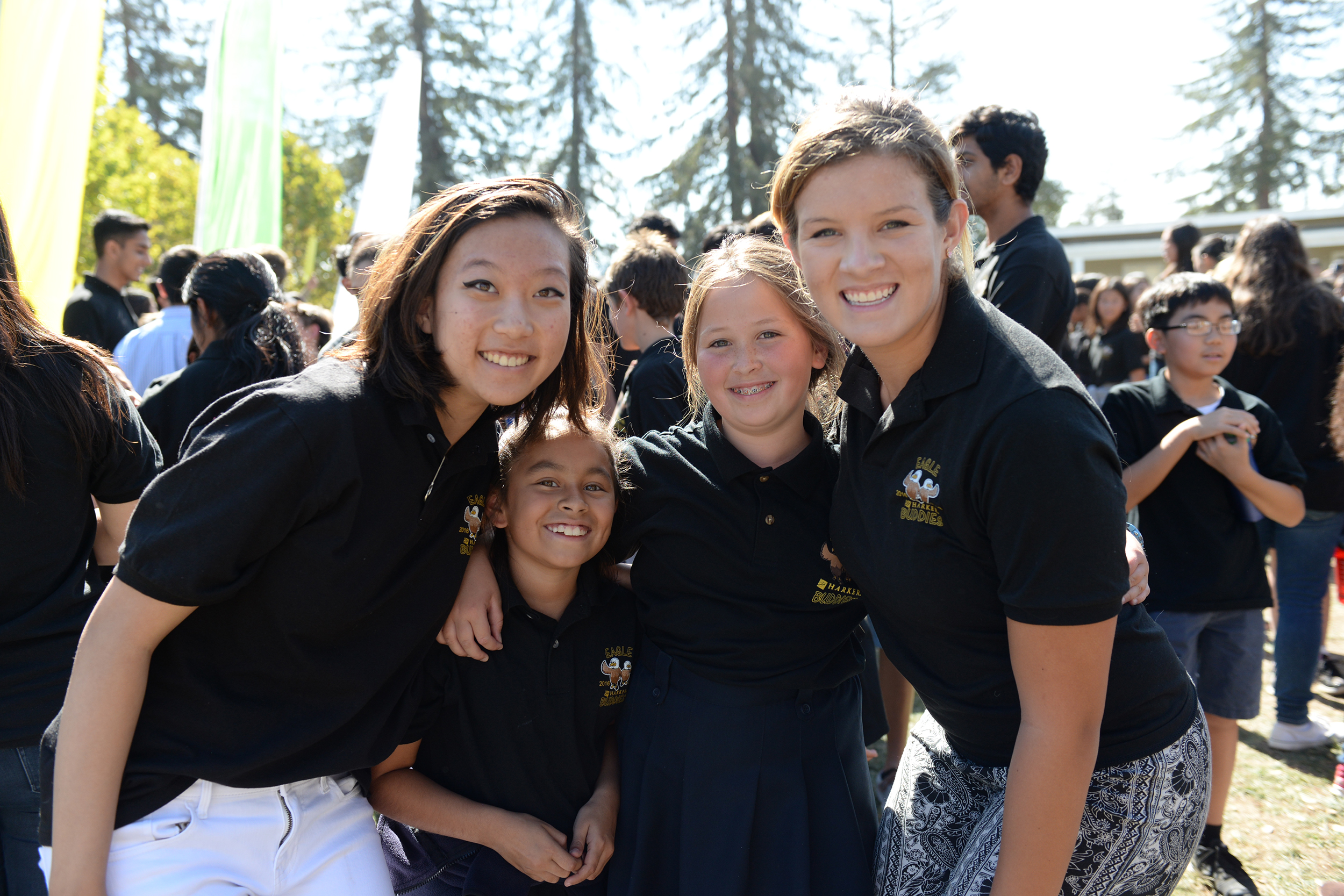This story originally appeared in the spring/summer 2020 issue of Harker Magazine.
One morning in October 2010, third graders gathered at the lower school campus field to await a busload of sophomores, with whom they’d spent weeks corresponding. As their friends approached, the students clapped and chanted “Eagle Buddies!” signaling that the new program was off to a promising start.
This fall, the Eagle Buddies program will begin its 10th year as a bridge between the lower and upper school communities. The program connects students in grades 3 and 10, and lasts until the lower school students finish grade 5 and the upper school students graduate. Once the younger students reach grade 10, they are introduced to grade 3 students and re-enter the program from the other perspective.
The inspiration for Eagle Buddies came from upper school head Butch Keller and upper school math teacher Jane Keller’s stint at a previous school, which had a similar program that paired younger and older students in an effort to help younger students forge lifelong bonds within the school.
“[At the school where I previously worked] in Virginia, we had a big brother, little brother, big sister, little sister program,” Jane Keller recalled. “And it was at a K-through-12 school. Granted, we were on one campus, so it was a little more inclusive, but it made a big difference for the little kids to be connected to the older students and for the older students to remember what it’s like to be young.”
Because Harker has multiple campuses, the Kellers felt it was even more important to provide a bridge between the school’s younger and older students. “If we get into our own little island and think only about what happens at the upper school without regard to the other campuses, and the other campuses may be feeling the same, that to me inhibits a smooth transition and growth process for our students,” said Butch Keller.
“We kind of all have to be beads on the same thread, so that we’re taking the steps in the same direction,” said Jane Keller. “Not necessarily the exact steps, because everybody does things differently, but we still have to be teaching the same elements, the same values along the way.”
The idea was met with excitement at the lower school, and planning began in summer 2010. Weeks before their first face-to-face meeting, the third graders and sophomores exchanged cards and messages to generate excitement for the kickoff. “I thought it was great because at the time my son [Matthew ’13] was part of the first class [of sophomore buddies],” said Kristin Giammona, elementary division head, who still remembers fondly the first visit by the sophomores. “Just seeing those kids get off the bus and how much they’d grown up [since elementary school], and then seeing how much the little kids loved them, it was just great.”
The enthusiasm from both the third graders and sophomores was precisely what organizers had been hoping to see. Lower schoolers in the program, Giammona said, enjoy learning more about their older buddies’ experiences and gaining a look into what their own daily lives will be like once they reach high school. “I think they just love the idea that that they get to go to the upper school campus,” she said. “The big kids show them, here’s my locker, here’s what I did during the day, this is what you should be doing.”
It also helps the lower school students feel closer to the community as a whole. “Meeting with upper school students helps the lower school students know that the upper school exists, and makes them feel like they’re part of the whole school,” said Butch Keller. “And it reminds our big kids of what it was like to be little.”
Many cross-campus activities have been organized for Eagle Buddies events, including carnival games, face painting, clown shows and visits to see buddies perform at annual shows, such as the upper school spring musical and the grade 5 show, as well as the yearly upper school visit to the lower school to celebrate the conclusion of the year’s Pajama Program. But often it is the less structured activities that create the most enduring memories.
Senior Jessica Jiang had an especially energetic younger buddy who once engaged her in an impromptu face-painting activity with another upper school friend, decorating their faces with eyebrows, hearts and mustaches. The experience was an example for Jiang of how Eagle Buddies gives upper school students a unique opportunity to be “extremely silly.”
“Most of the time I don’t think about having fun or relaxing or being in themoment, because there’s so much to do, both in school and outside of school,” she said. “In my experience, the Eagle Buddies program encourages whimsical exploration and simply having fun, which is just as important as being busy.”
Seniors who joined the program as third graders, such as Sachin Shah, found it beneficial to see how older students experienced the world, which they extended to their younger buddies once they reached the upper school. “I think that just getting a perspective on life from someone at a different stage of it was really nice,” Shah said. “I remember my older buddies trying to teach me how to enjoy middle school, and I remember trying to chase my younger buddies as they played soccer.”
Upper school students have found that simply learning to talk to someone several years younger than them has been a valuable experience. “Being in the Eagle Buddies program has taught me mainly that I have no idea how to talk to kids,” laughed Jiang. “I’m still figuring out how to best communicate with children, but I love how Eagle Buddies makes us learn how to interact with people younger than us.”
